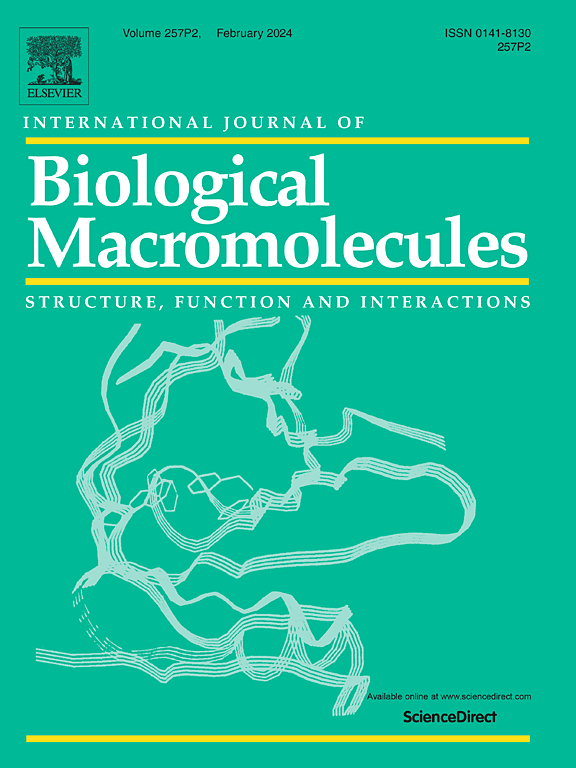Long-acting antibacterial nanochitin/nanocellulose bioplastic packaging film
IF 8.5
1区 化学
Q1 BIOCHEMISTRY & MOLECULAR BIOLOGY
International Journal of Biological Macromolecules
Pub Date : 2025-04-04
DOI:10.1016/j.ijbiomac.2025.142862
引用次数: 0
Abstract
Ensuring antimicrobial safety and durability remains a critical challenge in bioplastic packaging. In this study, a silver-loaded lignin/laponite antimicrobial agent (Lap@LAg) with outstanding long-term antibacterial properties was synthesized and subsequently incorporated with nanocellulose and nanochitin to fabricate a bioplastic film (CTF/Lap@LAg). The lignin-coated silver nanoparticles (AgNPs) were effectively immobilized on the laponite and uniformly dispersed throughout the matrix. The combined effects of laponite's confinement and electronegativity, along with the encapsulation capability of lignin, conferred prolonged antibacterial activity to Lap@LAg, achieving over 99.99 % bacteriostatic efficacy against E. coli and S. aureus. Furthermore, Lap@LAg demonstrated a remarkable long-lasting antibacterial effect, effectively protecting wood powder from mold contamination for 14 days. Moreover, the electrostatic and hydrogen bonding interactions among nanocellulose, nanochitin, and laponite, coupled with their multidimensional interwoven structure, imparted exceptional mechanical strength (Increased by 57.2 %) and superior barrier properties (WVP 0.082 g⋅mm/m2⋅d⋅kPa, OTR 0.077 cm3/m2⋅24h⋅0.1 MPa) to the film. This study provides valuable insights into the design of safe and long-lasting antibacterial bioplastic packaging.
长效抗菌纳米几丁质/纳米纤维素生物塑料包装膜
确保抗菌安全性和耐用性仍然是生物塑料包装的关键挑战。本研究合成了一种长期抗菌性能优异的载银木质素/拉脱土抗菌剂(Lap@LAg),并将其与纳米纤维素和纳米几丁质结合制成生物塑料薄膜(CTF/Lap@LAg)。木质素包覆银纳米粒子(AgNPs)有效地固定在拉脱土上,并均匀地分散在整个基质中。拉脱土的约束和电负性,以及木质素的包封能力的综合作用,使Lap@LAg具有持久的抗菌活性,对大肠杆菌和金黄色葡萄球菌的抑菌效果超过99.99%。此外,Lap@LAg显示出显着的持久抗菌效果,有效地保护木粉不受霉菌污染14天。此外,纳米纤维素、纳米几丁质和laponite之间的静电和氢键相互作用,加上它们的多层交织结构,使薄膜具有优异的机械强度(提高57.2%)和优异的阻隔性能(WVP 0.082 g⋅mm/m2⋅d⋅kPa, OTR 0.077 cm3/m2⋅24h⋅0.1 MPa)。本研究为设计安全和持久的抗菌生物塑料包装提供了有价值的见解。
本文章由计算机程序翻译,如有差异,请以英文原文为准。
求助全文
约1分钟内获得全文
求助全文
来源期刊
CiteScore
13.70
自引率
9.80%
发文量
2728
审稿时长
64 days
期刊介绍:
The International Journal of Biological Macromolecules is a well-established international journal dedicated to research on the chemical and biological aspects of natural macromolecules. Focusing on proteins, macromolecular carbohydrates, glycoproteins, proteoglycans, lignins, biological poly-acids, and nucleic acids, the journal presents the latest findings in molecular structure, properties, biological activities, interactions, modifications, and functional properties. Papers must offer new and novel insights, encompassing related model systems, structural conformational studies, theoretical developments, and analytical techniques. Each paper is required to primarily focus on at least one named biological macromolecule, reflected in the title, abstract, and text.

 求助内容:
求助内容: 应助结果提醒方式:
应助结果提醒方式:


